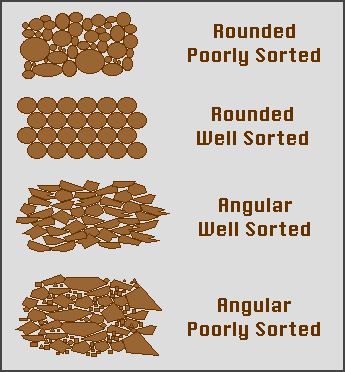
(Diagram created by Prof. Ian Williams, UW - River Falls)

Sorting is a term usually applied to sediments or sedimentary rock, and describes the degree of uniformity of grain size. The degree of sorting depends upon how much transport the sediment has undergone.
Well-sorted sediments have grains of similar size, and are the result of much sediment transport and earth processes which segregated the sediment by depositing different size fractions in different places. Coarse sediments are usually found closest to the source area because they are too heavy to be transported far, while fine sediments such as silt and clay travel the farthest. Examples of well-sorted sediment include quartz sandstones (see the 2nd diagram above - rounded, well-sorted) and shales (3rd diagram, angular well-sorted).
Poorly-sorted sediments have grains of varying sizes, and are evidence of sediments that have been deposited fairly close to the source area, i.e., have not undergone much transport. Streambed gravel (a sediment) or conglomerate (a sedimentary rock) containing sand and silt is an example of a rounded, poorly-sorted sediment (1st diagram). Glacial till, containing a mixture of coarse angular rock fragments, sand, silt, and clay, was deposited by the slow plowing action of an ice sheet, and is a good example of an angular, poorly-sorted sediment. Other examples of angular, poorly-sorted rocks are breccia and arkose sandstone.